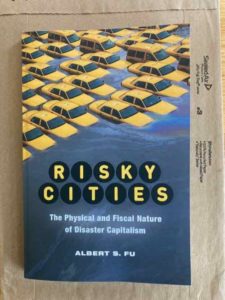New Book — ‘Risky Cities: The Physical and Fiscal Nature of Disaster Capitalism’ by Albert
 A new book explores one of my favorite topics: the overlap of urbanization, capitalism, and disasters. Think our bad habit of developing in flood plains, then acting shocked when levees results in flooding elsewhere. The term “disaster capitalism” is very appropriate.
A new book explores one of my favorite topics: the overlap of urbanization, capitalism, and disasters. Think our bad habit of developing in flood plains, then acting shocked when levees results in flooding elsewhere. The term “disaster capitalism” is very appropriate.
Over half the world’s population lives in urban regions, and increasingly disasters are of great concern to city dwellers, policymakers, and builders. However, disaster risk is also of great interest to corporations, financiers, and investors. Risky Cities is a critical examination of global urban development, capitalism, and its relationship with environmental hazards. It is about how cities live and profit from the threat of sinkholes, garbage, and fire. Risky Cities is not simply about post-catastrophe profiteering. This book focuses on the way in which disaster capitalism has figured out ways to commodify environmental bads and manage risks. Notably, capitalist city-building results in the physical transformation of nature. This necessitates risk management strategies –such as insurance, environmental assessments, and technocratic mitigation plans. As such capitalists redistribute risk relying on short-term fixes to disaster risk rather than address long-term vulnerabilities. (Rutgers University Press)
You can read the introduction at Barnes and Noble.
— Steve Patterson